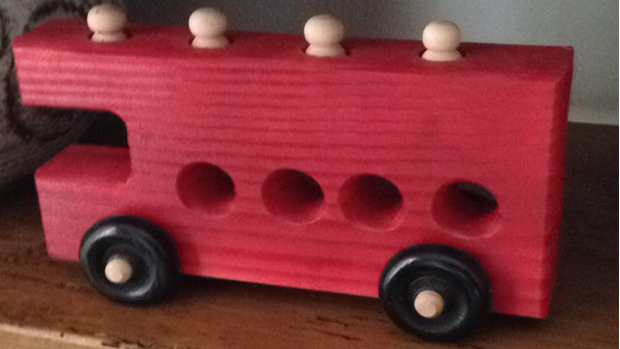
by Alex Thiel
Though Double Decker has earned a reputation as an annual highlight of Oxford’s art calendar, some vendors and exhibitions can stretch the definition of “art.” Red Byrd does just this, in a way that seems fun and unforced.
“When [my grandson] was born, I started to make toys for him. I didn’t know how to make toys. I just started fooling with them because I liked them myself.”
“As a little boy, I didn’t have a lot of toys, so I thought maybe I’d try to make some for him.”
From such unassuming beginnings sprang one of Double Decker’s more unique traditions. Red Byrd has built and sold handmade wooden toys in Oxford even before Double Decker was founded.
“I’ve been doing it ever since then. [My grandson] is thirty-four years old now, and I got two great-grandsons on top of that. Of course, I’m making toys for them, too.”
Byrd is a retired telephone man and a fifty-nine-year resident of Oxford. He’s the type of guy who, when called for an interview, asks whether or not “it’s going to cost [him] anything.” Still, despite the old-fashioned nature of his craft, it wouldn’t be fair to call his exhibition a relic.
“Everybody knows where I am,” he brags. “Little kids come see me and spend their money. You need to come over in front of Ajax. That’s my spot.”
He specializes in recreating various vehicles and machines, particularly those models that have faded with time. His first toy was a replica of a Ford Model-T that he owned as a young man. “I sort of remembered what it looked like and tried to make one. It grew from there. I’m eighty-seven years old, so you know how old that thing is.”
Eventually, the toys became more complex and ambitious.
“I started making airplanes. I sell lots of trains. A train that spells out the name of “Rebels.” Even for little kids, too. Names like ‘John,’ I’ll spell out J-O-H-N, and it’s got a little engine and a caboose on it.”
“I make a dragline. The derrick goes up and down, turns around. In fact, I don’t even have one now. I’m going to make one before Double Decker. I don’t sell many of them, because they’re so hard to make.”
He has been known to branch out of this mold, however, citing bows and arrows as his “biggest seller.” He’s also made a replica of Noah’s Ark, with an eighteen-inch ship and forty-eight tiny animals.
Byrd doesn’t seem to pay any mind to fitting in among the other tents dotting the square. “A lot of the time,” he explains, “people say ‘Are you an artist?’. Well, I don’t know if I’m an artist or not, but making wooden toys? You take a flat board, and you wind up making a train or an airplane.”
Byrd doesn’t seem to have any bigger aspirations for his woodworking hobby, despite many requests and inquisitions over the years. “I don’t even attempt to make furniture. It’s too complicated, and I’m not that smart anyway.”
“It makes a difference when you do something you like to do. I’ve been retired now for twenty-eight years. I don’t have anything else to do with my time, so that’s what I do.”
Call it an art, or call it a craft. It’s refreshing, perhaps, to see such an unpretentious exhibition at an arts festival. At any rate, a visit to Byrd’s tent at Double Decker is sure to yield a warm conversation. “I’m a big talker,” he brags.


